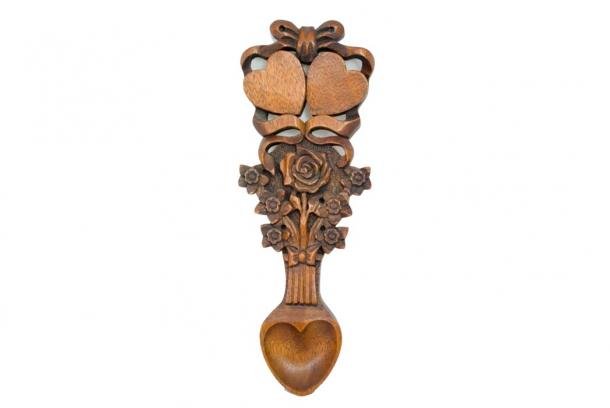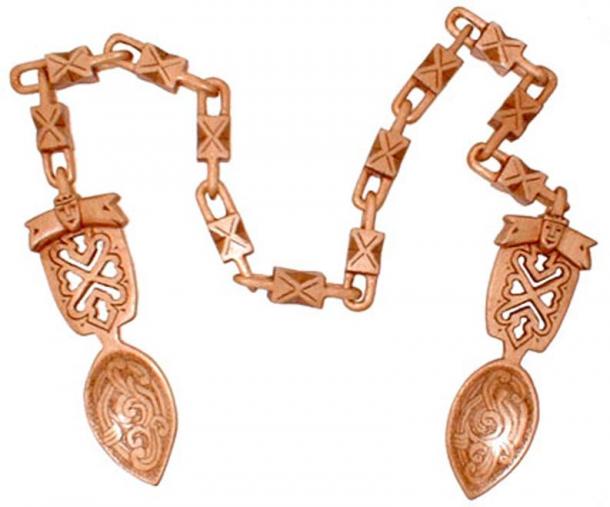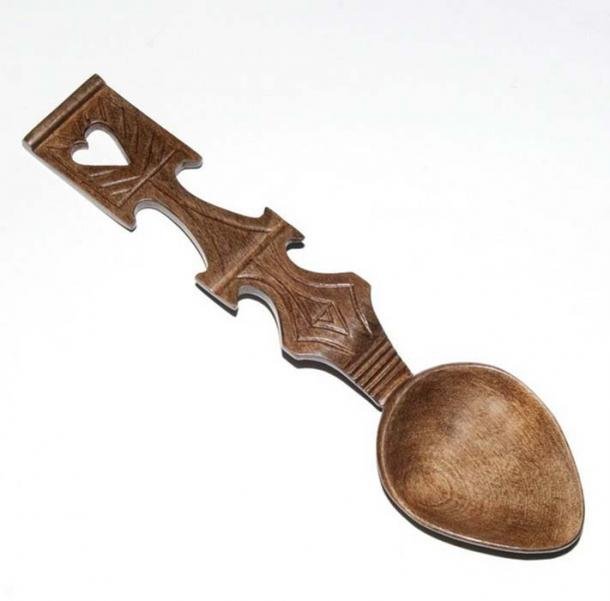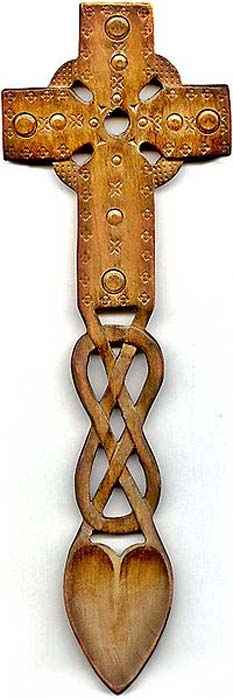Roses are red
Violets are blue,
Presenting a spoon
Means I love you
While one often thinks of presenting his/her loved ones with flowers or candy as a gesture of romance, it was once more common to present one’s loved ones with love spoons, “wooden (ivory or bone) spoons for symbolic/ceremonial rather than utilitarian purposes…” Beginning around 1667, Welsh love spoons joined an already rich tradition, and “spooning” a possible or current partner became an important aspect of Welsh and British romance.

An intricately decorated Welsh Lovespoon. ( Neil /Adobe Stock)
Why Love Spoons?
While there are similar traditions in Scandinavian countries as well; this article will focus specifically on the Welsh tradition. The Welsh love spoon is precisely what it sounds like—a spoon elaborately adorned and presented to a romantic partner (or hopeful partner).
The earliest known example of a Welsh love spoon dates to 1667 and is currently housed in the collection of the Welsh Folk museum in Cardiff. In the early days, love spoons were commonly a type of soup spoon and were functional. However, this aspect of the tradition appears to have faded quickly when the spoons became more decorative. Welsh love spoons likely maintain a longer lifespan by keeping them as a decoration that is hung on a wall than used to serve food as well.

Norwegian wedding spoons. (Vladimir Alexiev/ CC BY SA 4.0 )
While some might view these spoons as akin to promise rings or engagement rings , it appears—with some evidence—that this was not actually what these spoons were intended for. (This may change should evidence supporting this claim be discovered.) At this point, all that scholars of early modern Europe can assume is that the giving and receiving of love spoons indicates an unspoken agreement to begin courtship.
Welsh Love Spoon Symbols and Meanings
Just as flowers gained symbolic meaning in the Victorian period , Welsh love spoons could have a wide variety of images carved into them , each with different meanings. The most common symbols maintain their symbolism today across cultures. Many of these symbols are somewhat obvious, as they fall into three major groups:
- Good-luck symbols —horseshoe, four leaf clover, wheel of fortune, wishbone, sheath of corn, sea scenes, ships’ wheel, and anchor.
- Love symbols —the heart in its many variations, the lover’s knot, entwined stems, the vine motif, chain links, keyholes, lock and key, double spoons, love-birds (doves).
- Fertility symbols —cage and spheres, life spiral, acorn, and oak leaf.
Bells were also a common symbol of love and luck, as they signify the marriage bells commonly rung in church weddings. Other symbols listed above might appear more unique to modern eyes, as their meaning has ancient roots and has been overshadowed in recent centuries. The wheel, for example, represents unending support.

Welsh lovespoon with hearts, a wheel, and a lock. ( Public Domain )
In previous cultures—such as that of the Celts—the wheel often symbolized eternity, as it is an unbreakable circle of time, love, etc. When viewed through this lens, the connection to the love spoon meaning of support seems evident. It was also common to depict caged balls on these love spoons as an indication of how many children a couple hoped to bear.
Another popular symbol was the anchor, in part because many of the spoons were crafted by sailors while they were away from their lovers on long journeys at sea. The inclusion of an anchor was also seen as a symbol of security and/or a desire to settle down.
The Ancient Origins of Welsh Love Spoons
It does appear that there are further ancient origins in not only the Welsh love spoon tradition but in other variations of this type of artifact as well; all of which are likely based on a pre-Christian belief in the magic of wood .
The Celtic culture of ancient Britain in particular valued trees as sacred, and Arthurian lore expanded upon this tradition in the early medieval period (due to the importance of Avalon and the Isle of Apples, also known as the Isle of the Blessed ).

Welsh love spoons are traditionally made of wood. ( National Museum Wales )
Further, some of the letters in the writing system of the early Irish, called ogham, were modelled off of trees, and the name of the system itself is a mnemonic device made up of tree names. The significance of trees, and therefore wood, in the origin of the Welsh culture is also highly prominent. The introduction of the Welsh love spoon is not a far-cry from other more ancient, regional traditions.
Will Love Spoon Popularity be Revived?
While there does appear to be a rather rich tradition of exchanging love spoons in Welsh culture, their precise origin—why a spoon, for instance—remains uncertain. What is certain is that Welsh love spoons were exchanged between potential romantic partners, and—more beneficial for scholarly research— they were generally not intended for use. As such, many spoons survive and can be correlated to written Welsh (and/or Scandinavian, German, etc.) documents.
Perhaps the tradition of gifting love spoons will expand even more in light of recent exposure. For example, these romantic tokens are said to be exchanged by some modern couples looking to express their love on Valentine’s Day. People have also gifted Welsh love spoons as souvenirs from their trip to Wales, or on weddings, christenings, birthdays, or anniversaries. The traditional love spoons have also, unexpectedly, inspired modern fashion .

A love spoon is an ornately carved spoon traditionally made from a single piece of wood by young men, especially in Wales, as a love token for their sweethearts, to show their affection and intentions. ( Public Domain )
Top Image: A modern Welsh love spoon on rose petals. Source: marilyn barbone /Adobe Stock
Updated on October 13, 2020.
References
Roese, Herbert E. 1988. “Lovespoons in Perspective.” Bulletin of the Board of Celtic Studies, 35.1. page 106. Accessed March 8, 2018. http://www.lovespoons.250x.com/index%20Lovespoons.htm
Roese, Herbert E. 1988. “Lovespoons in Perspective.” Bulletin of the Board of Celtic Studies, 35.1. page 107. Accessed March 8, 2018. http://www.lovespoons.250x.com/spoons3.htm
Cadwyn Welsh Love Spoons. 2018. “Welsh Lovespoons: hand carved lovespoons from Wales.” Accessed March 15, 2018. https://www.welsh-lovespoons.co.uk/symbols
Opie, I. and P. Opie. 1951. The Oxford Dictionary of Nursery Rhymes . Oxford University Press. p. 375
Western, David. “History Explained: Lovespoons” davidwesternlovespoons. Accessed March 11, 2018. http://www.davidwesternlovespoons.com/www.davidwesternlovespoons.com/History_Explained.html
Western, David. 2012. History of Lovespoons . Pennsylvania: Fox Chapel Publishers.
Related posts:
Views: 0
 RSS Feed
RSS Feed

















 October 14th, 2020
October 14th, 2020  Awake Goy
Awake Goy 




 Posted in
Posted in  Tags:
Tags: 
















